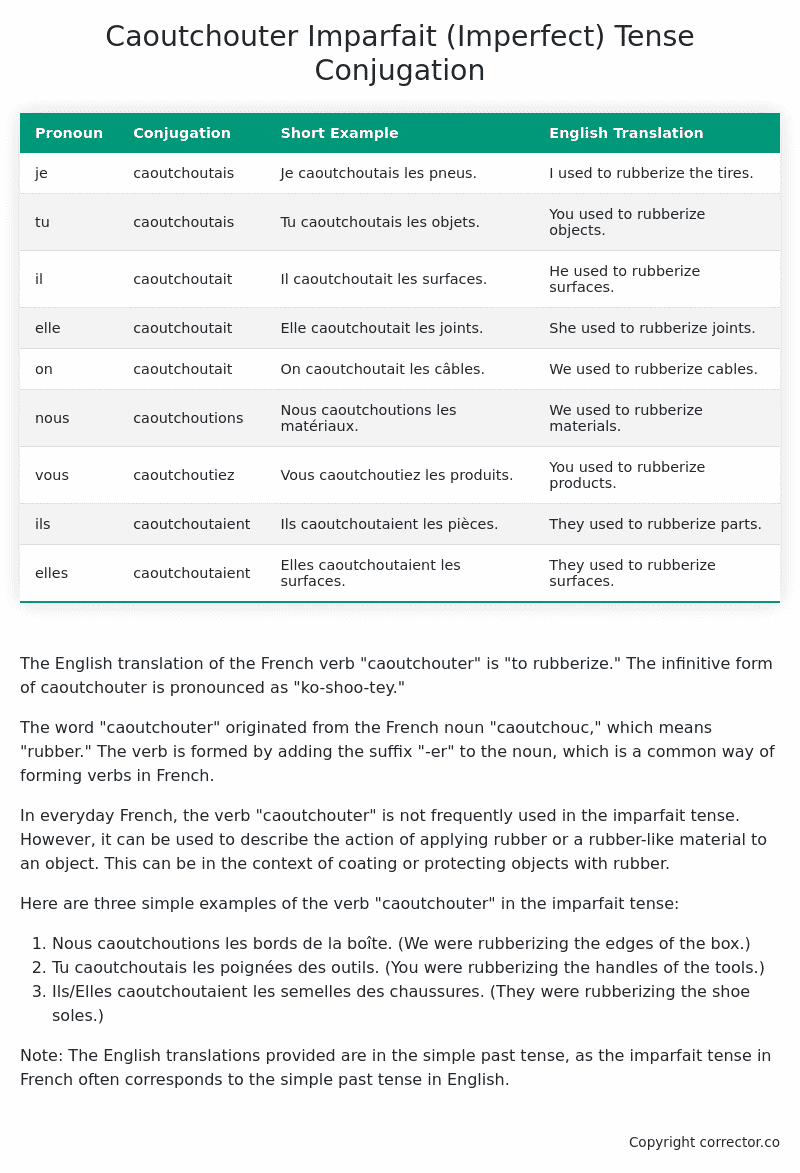Imparfait (Imperfect) Tense Conjugation of the French Verb caoutchouter
Introduction to the verb caoutchouter
The English translation of the French verb “caoutchouter” is “to rubberize.” The infinitive form of caoutchouter is pronounced as “ko-shoo-tey.”
The word “caoutchouter” originated from the French noun “caoutchouc,” which means “rubber.” The verb is formed by adding the suffix “-er” to the noun, which is a common way of forming verbs in French.
In everyday French, the verb “caoutchouter” is not frequently used in the imparfait tense. However, it can be used to describe the action of applying rubber or a rubber-like material to an object. This can be in the context of coating or protecting objects with rubber.
Here are three simple examples of the verb “caoutchouter” in the imparfait tense:
- Nous caoutchoutions les bords de la boîte. (We were rubberizing the edges of the box.)
- Tu caoutchoutais les poignées des outils. (You were rubberizing the handles of the tools.)
- Ils/Elles caoutchoutaient les semelles des chaussures. (They were rubberizing the shoe soles.)
Note: The English translations provided are in the simple past tense, as the imparfait tense in French often corresponds to the simple past tense in English.
Table of the Imparfait (Imperfect) Tense Conjugation of caoutchouter
| Pronoun | Conjugation | Short Example | English Translation |
|---|---|---|---|
| je | caoutchoutais | Je caoutchoutais les pneus. | I used to rubberize the tires. |
| tu | caoutchoutais | Tu caoutchoutais les objets. | You used to rubberize objects. |
| il | caoutchoutait | Il caoutchoutait les surfaces. | He used to rubberize surfaces. |
| elle | caoutchoutait | Elle caoutchoutait les joints. | She used to rubberize joints. |
| on | caoutchoutait | On caoutchoutait les câbles. | We used to rubberize cables. |
| nous | caoutchoutions | Nous caoutchoutions les matériaux. | We used to rubberize materials. |
| vous | caoutchoutiez | Vous caoutchoutiez les produits. | You used to rubberize products. |
| ils | caoutchoutaient | Ils caoutchoutaient les pièces. | They used to rubberize parts. |
| elles | caoutchoutaient | Elles caoutchoutaient les surfaces. | They used to rubberize surfaces. |
Other Conjugations for Caoutchouter.
Le Present (Present Tense) Conjugation of the French Verb caoutchouter
Imparfait (Imperfect) Tense Conjugation of the French Verb caoutchouter (You’re reading it right now!)
Passé Simple (Simple Past) Tense Conjugation of the French Verb caoutchouter
Passé Composé (Present Perfect) Tense Conjugation of the French Verb caoutchouter
Futur Simple (Simple Future) Tense Conjugation of the French Verb caoutchouter
Futur Proche (Near Future) Tense Conjugation of the French Verb caoutchouter
Plus-que-parfait (Pluperfect) Tense Conjugation of the French Verb caoutchouter
Passé Antérieur (Past Anterior) Tense Conjugation of the French Verb caoutchouter
Futur Antérieur (Future Anterior) Tense Conjugation of the French Verb caoutchouter
Subjonctif Présent (Subjunctive Present) Tense Conjugation of the French Verb caoutchouter
Subjonctif Passé (Subjunctive Past) Tense Conjugation of the French Verb caoutchouter
Subjonctif Imparfait (Subjunctive Imperfect) Tense Conjugation of the French Verb caoutchouter
Conditionnel Présent (Conditional Present) Tense Conjugation of the French Verb caoutchouter
Conditionnel Passé (Conditional Past) Tense Conjugation of the French Verb caoutchouter
Conditionnel Passé II (Conditional Past II) Tense Conjugation of the French Verb caoutchouter
L’impératif Présent (Imperative Present) Tense Conjugation of the French Verb caoutchouter
L’impératif Passé (Imperative Past) Tense Conjugation of the French Verb caoutchouter
L’infinitif Présent (Infinitive Present) Tense Conjugation of the French Verb caoutchouter
L’infinitif Passé (Infinitive Past) Tense Conjugation of the French Verb caoutchouter
Le Participe Présent (Present Participle) Tense Conjugation of the French Verb caoutchouter
Le Participe Passé (Past Participle) Tense Conjugation of the French Verb caoutchouter
Struggling with French verbs or the language in general? Why not use our free French Grammar Checker – no registration required!
Get a FREE Download Study Sheet of this Conjugation 🔥
Simply right click the image below, click “save image” and get your free reference for the caoutchouter imparfait tense conjugation!

Caoutchouter – About the French Imparfait Tense
NOTE: To take a deep dive into all the French tenses then see our article on Mastering French Tense Conjugation.
Formation of the Imparfait Tense
For regular -er verbs:
For regular -ir verbs
For regular -re verbs
Common Everyday Usage Patterns
Description of Past Habits
Background Information
Mental and Emotional States
It’s employed to express emotions, thoughts, or physical sensations in the past. For example: “J’étais content quand il est arrivé.” (I was happy when he arrived.)
Ongoing Actions
Points to Note About the Imparfait Tense
Passé Composé vs. Imparfait
Conditional
Si Clauses
Narration
I hope you enjoyed this article on the verb caoutchouter. Still in a learning mood? Check out another TOTALLY random French verb imparfait conjugation!


